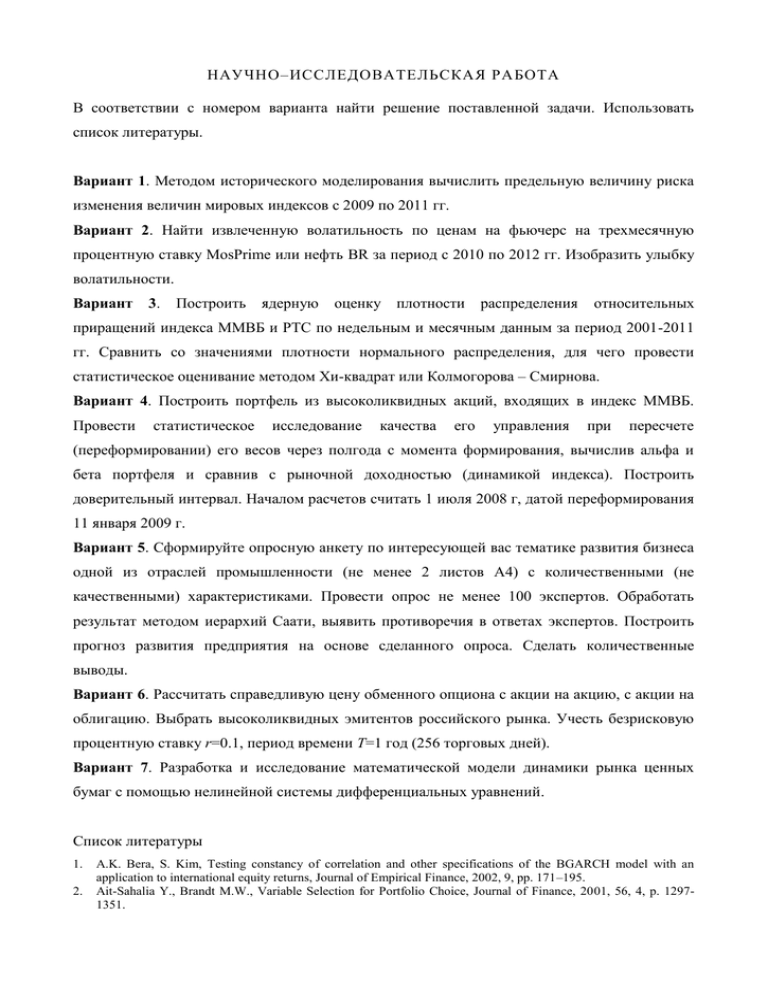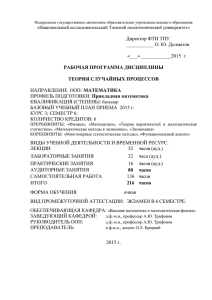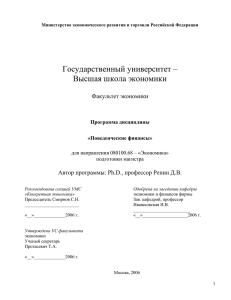НАУЧНО–ИССЛЕДОВАТЕЛЬСКАЯ РАБОТА
advertisement

НАУЧНО–ИССЛЕДОВАТЕЛЬСКАЯ РА БОТА В соответствии с номером варианта найти решение поставленной задачи. Использовать список литературы. Вариант 1. Методом исторического моделирования вычислить предельную величину риска изменения величин мировых индексов с 2009 по 2011 гг. Вариант 2. Найти извлеченную волатильность по ценам на фьючерс на трехмесячную процентную ставку MosPrime или нефть BR за период с 2010 по 2012 гг. Изобразить улыбку волатильности. Вариант 3. Построить ядерную оценку плотности распределения относительных приращений индекса ММВБ и РТС по недельным и месячным данным за период 2001-2011 гг. Сравнить со значениями плотности нормального распределения, для чего провести статистическое оценивание методом Хи-квадрат или Колмогорова – Смирнова. Вариант 4. Построить портфель из высоколиквидных акций, входящих в индекс ММВБ. Провести статистическое исследование качества его управления при пересчете (переформировании) его весов через полгода с момента формирования, вычислив альфа и бета портфеля и сравнив с рыночной доходностью (динамикой индекса). Построить доверительный интервал. Началом расчетов считать 1 июля 2008 г, датой переформирования 11 января 2009 г. Вариант 5. Сформируйте опросную анкету по интересующей вас тематике развития бизнеса одной из отраслей промышленности (не менее 2 листов А4) с количественными (не качественными) характеристиками. Провести опрос не менее 100 экспертов. Обработать результат методом иерархий Саати, выявить противоречия в ответах экспертов. Построить прогноз развития предприятия на основе сделанного опроса. Сделать количественные выводы. Вариант 6. Рассчитать справедливую цену обменного опциона с акции на акцию, с акции на облигацию. Выбрать высоколиквидных эмитентов российского рынка. Учесть безрисковую процентную ставку r=0.1, период времени T=1 год (256 торговых дней). Вариант 7. Разработка и исследование математической модели динамики рынка ценных бумаг с помощью нелинейной системы дифференциальных уравнений. Список литературы 1. 2. A.K. Bera, S. Kim, Testing constancy of correlation and other specifications of the BGARCH model with an application to international equity returns, Journal of Empirical Finance, 2002, 9, pp. 171–195. Ait-Sahalia Y., Brandt M.W., Variable Selection for Portfolio Choice, Journal of Finance, 2001, 56, 4, p. 12971351. 3. 4. 5. 6. 7. 8. 9. 10. 11. 12. 13. 14. 15. 16. 17. 18. 19. 20. 21. 22. 23. 24. 25. 26. 27. 28. 29. 30. 31. 32. 33. 34. 35. Ait-Sahalia Y., Lo A.W., Nonparametric risk management and implied risk aversion, Journal of Econometrics, 2000, 94, p. 9-51. Ait-Sahalia Y., Jacod J., Estimating the Degree of Activity of Jumps in High Frequency Data, The Annals of Statistics, 2009, V. 37, 5A, p. 2202–2244. Ait-Sahalia Y., Mancini L., Out of sample forecasts of quadratic variation, Journal of Econometrics, 2008, 147, p. 13–33. Alexander С., Chibumba A., Multivariate Orthogonal Factor GARCH, University of Sussex Discussion Papers in Mathematics, 1998. [Электронный ресурс] – Режим доступа: http://www.ismacentre.rdg.ac.uk, свободный. Alexander С., Market Models: A Practitioners Guide to Financial Data Analysis, J. Wiley and Sons, 2001. Alexander С., Principal component models for generating large GARCH Covariance Matrices, Economic Notes, 2002, V. 31, №2, p. 337-359. Artzner P., Delbaen F., Eber J.-M., Heath D., Coherent measures of risk, Mathematical Finance, 1998, 6, p. 203– 228. Barndorff-Nielsen O., Shephard N., Measuring the impact of jumps in multivariate price processes using bipower covariation. Working paper, Nuffield College, Oxford University, 2003. Benth F.E. Option Theory with Stochastic Analysis // An Introduction to Mathematical Finance. – Springer Verlag. –2002. – 168 p. Bliss R.R., Panigirtzoglou N., Option-Implied Risk Aversion Estimates, Journal of Finance, 2004, 59, 1, p. 407446. Bollerslev T., Generalized autoregressive conditional heteroskedasticity, Journal of Econometrics, 1986, 31, p. 307–327. Bollerslev T., Modelling the Coherence in Short-Run Nominal Exchange Rates: A Multivariate Generalized ARCH model, The Review of Economics and Statistics, 1990, V.72, №3, p. 498–505. Bollerslev T., Woolridge J.M., Quasi-Maximum Likelihood Estimation and Inference in Dynamic Models with Time Varying Covariances, Econometric Reviews, 1992, 11, p. 143-172. Bollerslev T., Tzuo Hann Law, Tauchen G., Risk, jumps, and diversification, Journal of Econometrics, 2008, 144, p. 234-256. Byung Jin Kanga, Tong Suk Kim, Empirical risk aversion functions-estimates and assessment of their reliability, International Review of Financial Analysis, 2007, doi:10.1016/j.irfa.2007.08.002. C. Brooks, A.D. Clare, J.W. Dalle Molle, G. Persand, A comparison of extreme value theory approaches for determining value at risk, Journal of Empirical Finance, 12, Issue 2, 2005, p.339-352. C. Marinelli, S. d'Addona, S.T. Rachev, A Comparison of some univariate models for Value-at-Risk and expected shortfall, Technical Report of University of Karlsruhe, 2006. Chen Y., Härdle W., Spokoiny V., Portfolio value at risk based on independent component analysis, Journal of Computational and Applied Mathematics, 2007, 205, p. 594–607. Cheng G., Li P., Shi P., A new algorithm based on copulas for VaR valuation with empirical calculations, Theoretical Computer Science, 2007, 378, p. 190–197. D.F. Kraft, R.F. Engle, Autoregressive conditional heteroskedasticity in multiple time series models. Discussion Paper 82-23, USA, University of California, San Diego, CA, 1982. Dennis Bams, Thorsten Lehnert, Christian C.P. Wolff, An evaluation framework for alternative VaR-models, Journal of International Money and Finance, 24, Issue 6, 2005, p. 944-958. Dragulescu A.A., Yakovenko V.M. Probability distribution of returns in the Heston model with Stochastic volatility // Quantitative Finance. – 2002. – v. 2. – P. 443–453. Embrechts P., Kluppelberg C., Mikosh T., Modeling Extreme Events, Springer Verlag, 1997. Engle R.F., Dynamic conditional correlation – a simple class of multivariate GARCH models, Journal of Business and Economic Statistic, 2002, 20, p. 339 – 350. F.X. Diebold, M. Nerlove, The dynamics of exchange rate volatility: a multivariate latent factor ARCH model. Journal of Applied Econometrics, 1989, 4, p. 1–21. Fiorentini G., Leon A., Rubio G. Estimation and empirical performance of Heston’s stochastic volatility model: the case of a thinly traded market //Journal of Empirical Finance. – 2002. – v. 9. – P. 225–255. G. A. Young, R. L. Smith, Essentials of Statistical Inference, Cambridge Series in Statistical and Probabilistic Mathematics, Cambridge University Press, 2005, 236 p. G. Samorodnitsky, M.S. Taqqu, Stable Non–Gaussian Random Processes, New York, Chapmen and Hall Press, 1994. Giamouridis D., Vrontos I., Hedge fund portfolio construction: A comparison of static and dynamic approaches, Journal of Banking & Finance, 2007, 31, p. 199–217. Herman J. Bierens, Introduction to the Mathematical and Statistical Foundations of Econometrics, Cambridge University Press, 2005, 317 p. Heston S.L. A closed form solution for options with stochastic volatility with applications to bond and currency option // Rev. Financial Studies. – 1993. – v.6. – P. 327–343. Hong Liu, Optimal Consumption and Investment with Transaction Costs and Multiple Risky Assets, Journal of Finance, 2004, 59, 1, p. 289-338. Hull J. Options, Futures, and Other Derivatives // Prentice-Hall, Saddle River. – New Jersey. – 2003. –755 p. 36. Hull J., White A. The Pricing of Options on Assets with Stochastic Volatility Models // Journal of Finance. – 1987. – v. 42. – P. 281– 300. 37. I.D. Vrontos, P. Dellaportas, D.N. Politis, A full-factor multivariate GARCH model, Econometrics Journal, 2003, 6, pp. 312–334. 38. Janecek K., Shreve S.E., Asymptotic analysis for optimal investment and consumption with transaction costs, Finance and Stochastics, 2004, 8, p. 181-206. 39. Judd K.L., Kubler F., Schmedders K., Asset Trading Volume with Dynamically Complete Markets and Heterogeneous Agents, Journal of Finance, 2003, 58, 5, p. 2203-2218. 40. Kumar M., Persaud A., Pure contagion and investors' shifting risk appetite: analytical issues and empirical evidence, International Finance, 2002, 5, 3, p. 401–436. 41. Lando D. Credit Risk Modelling. Princeton, NJ: Princeton University Press, 2004, 312 p. 42. M. Billio, L. Pelizzon, Value-at-risk: a multivariate switching regime approach, Journal of Empirical Finance, 7, 2000, p. 531–554. 43. M. Pelagatti, S. Rondena, Dynamic Conditional Correlation with Elliptical Distributions, Università degli Studi di Milano-Bicocca, Dipartimento di Statistica, Working Papers 20060508, 2004. 44. Manganelli S., Engle R.F., CAViaR: Conditional Value at Risk by Quantile Regression, NBER, 1999, Working Paper 7341. 45. McNeil A.J., Frey R., Embrechts P., Quantitative Risk Management. Concepts, Techniques and Tools // Princeton University Press, Princeton, NJ, 2005. 46. Merton R.C. Option Pricing When Underlying Stock Returns Are Discontinuous // Journal of Financial Economics. – 1976. – v. 3. – P. 125 –144. 47. P. Giot, S. Laurent, Value-at-Risk for long and short trading positions, Journal of Applied Econometrics, 18, 2003, p. 641–664. 48. Poterba J.M., Stock Market Wealth and Consumption, Journal of Economic Perspectives, 2000, 14, 2, p. 99-118. 49. R. Engle, Autoregressive Conditional Heteroskedasticity with Estimates of the Variance of United Kingdom Inflation, Econometrica, 1982, V. 50, pp. 987-1007. 50. R.F. Engle, C.W.J. Granger, D. F. Kraft, Combining competing forecasts of inflation using a bivariate ARCH model. Journal of Economic Dynamics and Control, 1984, 8, p. 151–165. 51. Rachev S.T., Menn C., Fabozzi F.J., Fat–tailed and Skewed Asset Return Distribution. Implications for Risk Management, Portfolio Selection, and Option Pricing, John Wiley & Sons, Hoboken, USA, 2005. 52. Rosenberg J.V., Engle R.F., Empirical pricing kernels, Journal of Financial Economics, 2002, 64, p. 341–372. 53. S. Manganelli, Engle R.F., CAViaR: Conditional Value at Risk by Quantile Regression, NBER, 1999, Working Paper 7341. 54. S. Stoyanov, G. Samorodinsky, S.T. Rachev, S. Ortobelli, Computing the portfolio Conditional Value–At–Risk in the α–stable case, Technical Report of University of Karlsruhe, 2004. 55. Sansone A., Garofalo G., Asset price dynamics in a financial market with heterogeneous trading strategies and time delays, Physica A, 2007, 382, p. 247–257. 56. Ser–Huang Poon A Practical Guide to Forecasting Financial Market Volatility // John Wiley & Sons. –Chichester, England. – 2005. 57. Shepherd N., Harvey A. An assessing of stochastic volatility model coefficients// Journal of Business and Econ stat. – 1996. – v.14. – P. 429–434. 58. T. Bolerslev, R. Engle, J. Wooldridge, A capital asset pricing model with time varying covariances, Journal of Political Economy, 1988, 96, p. 116 – 131. 59. T. Jeantheau, Strong Consistency of Estimators for Multivariate ARCH models, Econometric Theory, 1998, 14, 70–86. 60. Tomety F.E., Worthmann K. Monte-Carlo Methode und stochastische Differentialgleichungen // Preprint, 16 Juny 2004. 61. Vicente R., at al. Common Underlying Dynamics in an Emerging Market: From Minutes to Months // arXiv:condmat/0402185. – v.1. – 6 Feb 2004. – 11 p. 62. Vrontos I.D., Dellaportas P., Politis D.N., A full-factor multivariate GARCH model, Econometrics Journal, 2003, 6, pp. 312–334. 63. Wilmott P. Introduces Quantitative Finance. Chichester, West Sussex: John Wiley & Sons Ltd., 2007. 2nd Edition. 696 p. 64. Zhang, L., Mykland P.A., Aït-Sahalia Y., A tale of two time scales: Determining integrated volatility with noisy high-frequency data, Journal of the American Statistical Association, 2005b, 100, p. 1394-1411. 65. Айвазян С.А., Мхитарян В.С. Прикладная статистика. Основы эконометрики. М.: ЮНИТИ–ДАНА, 2001, т.2, 656 с. 66. Бельснер О.А., Крицкий О.Л.. Применение одномерного STS-распределения для моделирования значений фондовых индексов// Известия ТПУ, 2007, т. 310, №1, с. 45-50. 67. Бухбиндер Г.Л., Чистилин К.М. Описание российского фондового рынка в рамках модели Гестона // Математическое моделирование. – 2005. – т.17. – №10. – С. 31–38. 68. Бухбиндер Г.Л., Чистилин К.М. Стохастическая динамика котировок акций РАО ЕЭС // Математическое моделирование. – 2005. – т.17. – №2. – С. 119–125. 69. Кривилев А.В. Основы компьютерной математики с использованием системы MathLab. М.: Лекс-Книга, 2005, 496 с. 70. Ширяев А.Н. Основы стохастической финансовой математики. М.: Наука, 1998. Т.2. 544с. 71. Щетинин Е.Ю. Математические модели и методы количественного анализа фондовых рынков с высокой волатильностью: дис. … докт. физ.–мат. наук : 05.13.18 : защищена 24.11.06 / Щетинин Евгений Юрьевич. – Тверь, 2006. – 220 с. 72. Щетинин Е.Ю. Статистический анализ структур экстремальных зависимостей на российском фондовом рынке// Финансы и кредит, 2005, т. 22, №190, с. 44-51. 73. Щетинин Е.Ю., Лапушкин А.С. Статистические методы и математические модели оценивания финансовых рисков// Математическое моделирование,2004, т.16, №5, с.40-54. 74. Энциклопедия финансового риск-менеджмента/ под ред. Лобанова А.А., Чугунова А.В. М.: Альпина, 2005, 878 с.

